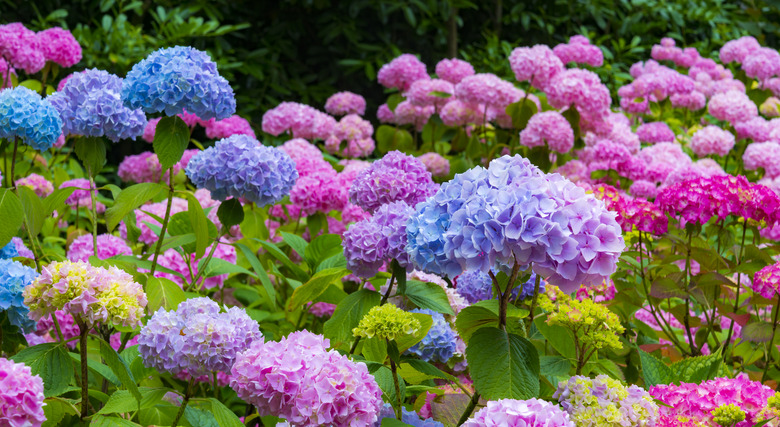Why Are My Hydrangea Leaves Turning Yellow?
We may receive a commission on purchases made from links.
Hydrangeas (Hydrangea spp.) aren't popular for their foliage – it's the blossoms people want to see. There's something about those huge, softly colored pompom-like flowers that gives so many gardeners a passion for this plant. The foliage, however, acts as a backdrop for the flower show, so when the leaves develop a problem, it mars the beauty of the entire plant.
Hydrangea leaves turning yellow isn't an attractive event, and the fear of losing the hydrangea is understandable. Rest assured, though, that there are few problems evidenced by yellow leaves that are life-threatening to your plant. However, pet owners should take note that Hydrangea arborescens is toxic and possibly life-threatening if ingested by dogs and cats.
Naturally Yellow Hydrangea Leaves
Naturally Yellow Hydrangea Leaves
Although a hydrangea with naturally green leaves turning yellow has a problem, be aware that some hydrangeas were bred to bear yellow leaves that may turn green with age. Hydrangea macrophylla 'Lemon Daddy,' for instance, has yellow foliage with yellow flowers that turn pink or blue. This particular hydrangea is hardy in U.S. Department of Agriculture plant hardiness zones 6 through 9. Hydrangea leaves also turn yellow naturally in the fall.
Hydrangea Leaf Scorch
Hydrangea Leaf Scorch
Hydrangea growers know that when their plant is wilting it needs water. Usually it will perk right up and go about the business of being gorgeous. If the leaves are turning yellow after a wilt, suspect leaf scorch, especially if the affected leaves are the ones on the top and the side of the hydrangea that receives the most sun. You may also notice brown tips and edges.
What the plant needs is shade, especially from the hot afternoon sun. Depending on variety, the hydrangea is hardy to USDA zones 3 through 9. Most care guides claim the plant can be grown in full sun and, if you live in the northern United States, that's true. Gardeners that grow hydrangea in the southern parts of the United States should plan on giving the hydrangea afternoon shade.
If you can't provide shade, water the hydrangea longer than you normally do and stick your finger into the soil periodically to ensure that it's not dry. Apply a 3- to 4-inch layer of mulch around the hydrangea to insulate the soil and keep it moist. Keep the mulch at least 2 inches from the base of the hydrangea to avoid rot.
Leaf Spot Yellowing
Leaf Spot Yellowing
Cercospora leaf spot, caused by the fungal pathogen Cercospora hydrangea, is a common disease of all hydrangea species. It is most prevalent during periods of warm, rainy weather. By the time the leaves are turning yellow, the disease is at an advanced state. Although the symptoms are unattractive, leaf spot isn't life-threatening.
You will notice the first symptoms – small purple spots – in mid-summer on the lower part of the hydrangea. These spots will become larger and turn gray or tan in the middle. Leaves then may turn yellow or brown and fall from the plant.
Prevent the disease from spreading by removing and destroying fallen leaves and watering the hydrangea at the soil, not overhead.
Fungicides aren't recommended unless the hydrangea persistently succumbs to the disease over several seasons. In that case, treat it with a fungicide that contains chlorothalonil. A pre-mixed product is readily available in garden centers and offers the most convenient way to treat the hydrangea.
Follow the label instructions carefully. As a general rule, spray the hydrangea in spring and ensure that the product covers all of the plant's foliage, except for the flowers, including the undersides of the leaves. Reapply once a week until no new symptoms appear. Wear a long-sleeved shirt, long pants, shoes, socks and chemical-resistant gloves when applying the fungicide. Avoid breathing the mist and do not allow people or pets into the area until the fungicide has dried.
Iron Chlorosis in Hydrangeas
Iron Chlorosis in Hydrangeas
Although any hydrangea can become chlorotic, the bigleaf cultivars (Hydrangea macrophylla), hardy to USDA zones 5b through 9a, are the most susceptible. Chlorosis describes a nutrient deficiency – the hydrangea isn't getting enough iron. If new leaves are turning yellow with veins, suspect iron chlorosis.
Treat the problem by adding chelated iron to the soil. While it's always best to follow the label instructions, as a general rule combine 1 1/4ounces of liquid chelated iron with 1 gallon of water. The amount of the solution to apply depends on the size of the hydrangea. Use 6 ounces if your plant is 1 to 3 feet in height and 12 ounces if it is 3 to 6 feet tall. Pour the solution directly on the soil beneath the hydrangea and water as you normally do.
If the problem persists, the soil pH may be too high. You can either keep reapplying the iron soil drench when symptoms appear or, for a more permanent solution, lower the soil's pH. Using pine bark mulch is one way to accomplish this. Another is through the application of sulfur to the soil. Apply 12 pounds of sulfur soil acidifier per 100 square feet to lower the pH by one point. Spread the product to the drip line and then water the hydrangea as you normally do.
Nitrogen Deficiency Turning Hydrangea Leaves Yellow
Nitrogen Deficiency Turning Hydrangea Leaves Yellow
If the older leaves of the hydrangea turn yellow, suspect a nitrogen deficiency. Thankfully, this one is simple to cure with ammonium sulfate. Apply 1/2 to 1 pound per 100 square feet. Scatter it evenly around the hydrangea and water afterward, as you normally do.
References
- Missouri Botanical Garden: Hydrangea Macrophylla 'Big Daddy'
- Old Farmer's Almanac: Hydrangea
- GardenTech: Daconil Fungicide
- The United States National Arboretum: Hydrangea Questions and Answers
- Do my own Pest Control: Espoma Soil Acidifier
- University of Florida Cooperative Extension Service: Hydrangea Macrophylla
